Reel Recommendations: Compartment No. 6
From 1896 to 2022, we are following the tracks to suggest 5 train-related films to accompany the release of Compartment No. 6 (dir. Juho Kuosmanen). Kuosmanen previously directed the warm-hearted comedy The Happiest Day in the Life of Olli Mäki (2016) and in Compartment No. 6 once again demonstrates a compassionately humanist vision in which unfolding relationships are realised with kind and observational subtlety. Over the imagined tannoy of cinema history, what departures, links and arrivals should be made to map the luminous rails of film?
As it glides into the station, the perspective of the shot transforms the flat screen into the bustle of a platform, several puffed clouds of smoke plume and trail and plume and trail and the train races into the foreground; carriages blurring past a line of expectant travellers as the stern conductor, sporting an equally stern Victorian moustache, paces into and out of view, and now the train begins to slow and now the doors are being opened – a rushing woman pushes through as a hand emerges from the carriage clutching a folded newspaper and suddenly, as if in synchronised abandon, the doors fan open welcoming the boarding passengers; welcoming the transit, the onwards and onwards, into the speeding and urgently modern landscape of motion…
The Lumiere Brother’s infamous film, The Arrival of the Train at La Ciotat Station (1895) was 50 seconds of footage that has since merged the founding myth of cinema inextricably with locomotive force. The legend goes that people fled the cinema, fearing the train would break through its flat projection and into the screaming audience (a moment recreated in Martin Scorcese’s Hugo, 2011). In reality the famed screening on December 28th 1895 did not include The Arrival of the Train at La Ciotat Station and there are, in fact, three versions of the film (there could be more, three have been found); the first two are from 1896 and the third dates from 1897. There is also now more research emerging that brings scepticism to the claim that people actually ran from their seats. Whatever the details, the Lumiere’s hurtling train ensured an early connection between the magic of film and the dynamism of trains. Print the legend, catch the train…
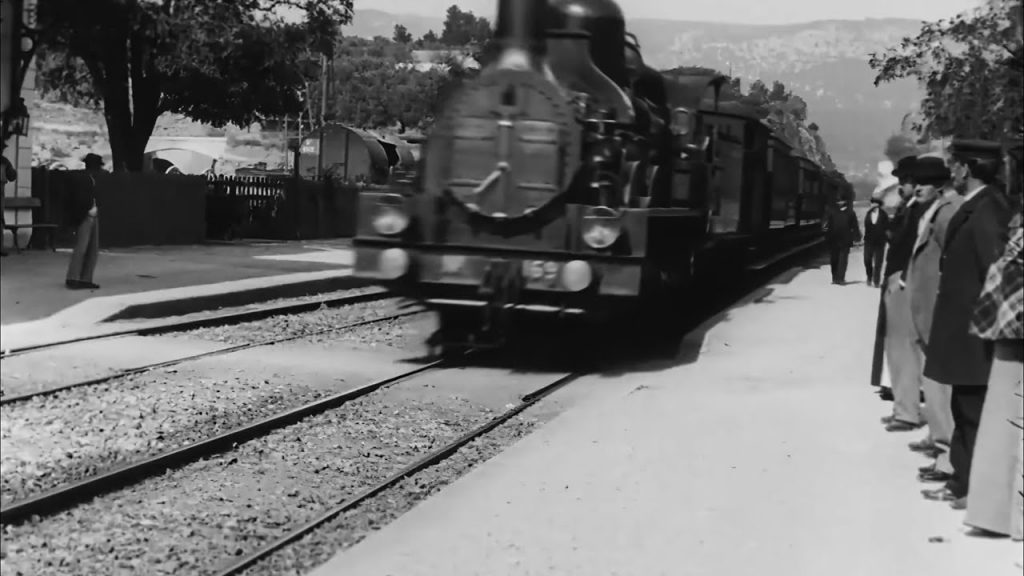
From 1896 to 2022, we are following the tracks to suggest 5 train-related films to accompany the release of Compartment No. 6 (dir. Juho Kuosmanen) and The Railway Children Return (dir. Morgan Matthews). Kuosmanen previously directed the warm-hearted comedy The Happiest Day in the Life of Olli Mäki (2016) and in Compartment No. 6 once again demonstrates a compassionately humanist vision in which unfolding relationships are realised with kind and observational subtlety. Meanwhile, The Railway Children Return is exactly what you would want from a film that returns to the heart-warming 1970 British classic (cue: a charming ensemble cast, the wide-eyed possibilities of childhood, rolling hills, hefty portions of nostalgia and, of course, trains). So…over the imagined tannoy of cinema history, what departures, links and arrivals should be made to map the luminous rails of film?
Railing Against the Silence
We should begin, naturally, with early cinema railing against the silence of its origins in the unheard but palpably loud rumble of locomotive outings aplenty: from the Lumiere’s to Edwin S. Porter’s 1903 gamechanger, The Great Train Robbery (another film, like The Arrival of the Train at La Ciotat Station, that has been shrouded in mythic claims); on to the genius comedy of Buster Keaton’s train acrobatics in The General (1926) or, in a very different tone, the looming shadow of industrial revolution that flickers throughout Alexander Dovzhenko’s imaginatively poetic Ukrainian trilogy: Zvenigora (1928), Arsenal(1929), and Earth (1930). Alternatively, we could take a different journey to examine the experimental connotations of the train in cinema – at the forefront of Futurism and Modernism, a romanticised evocation of time and space re-imagined in the advancement of change.

On the Tracks of the Avant-Garde
Henri Chomette, brother to the more well-known director René Clair (known for his radically inventive 1924 Dadaist film, Entr’acte, through to the 1945 commercial success of And Then There Were None, a defining Agatha Christie adaptation), made three shorts that elucidated the avant-garde concept of ‘Pure Cinema’: Jeux des reflets et de la vitesse (1923), A quoi rêvent les jeunes filles? (1924) and Cinq minutes de cinéma pur (1925). These films were stripped back to the interactions of light, shape and movement, and the first of the three, Jeux des reflets et de la vitesse (Play with Reflections and Speed) significantly uses speeding footage from a train. This sequence used a camera technique known as the ‘phantom ride’ which strapped a camera to the front of a vehicle in order to document the passing landscape from that speeding point of view (this spawned a whole genre of such films dating back to the 1890s). The term ‘Phantom Ride’ has also been used recently as the title for a beautiful 2019 Canadian experimental film by the filmmaker Stephen Broomer.
Then there is the kinetic flamboyance of early innovator Dziga Vertov , in his early 1929 classic, Man with a Movie Camera, a Marxist inspired paean to Soviet progress and one of the most spellbinding city-symphony films ever made. More importantly however, it features some jaw-dropping train japes! With inventive use of cutting and a nail-biting shot of a man in the foreground with his head on the tracks – complete with oncoming train speeding towards him – Vertov shows the thrill of danger, speed and modernity that ties the titular cameraman to the symbol of the train.
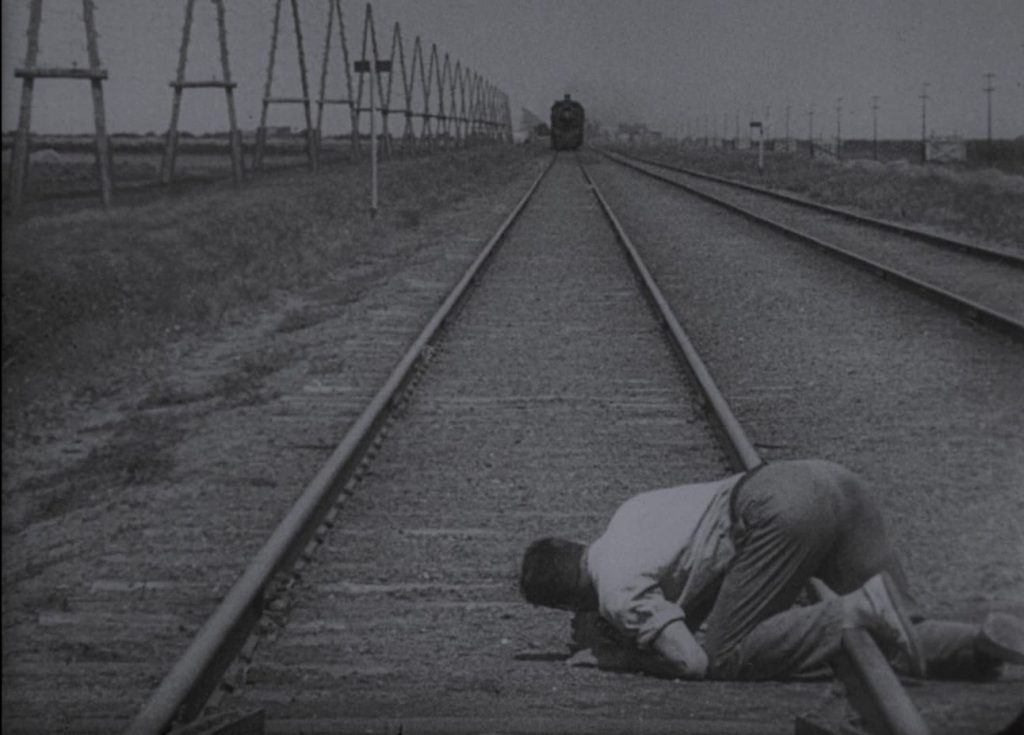
From a Russian milestone in documentary to a British documentary, both connected across time by the drama of railway tracks. In 1936, Harry Watt and Basil Wright directed a film that detailed the role of the train across London, Midlands and Scotland in distributing post. With a commentary by John Grierson (a leading Scottish documentary-maker) and Stuart Legg (often overlooked but an active director and documentary-maker in the UK and Canada), the film also featured a score by Benjamin Britten and culminated with a poem, written and read by W.H. Auden. The train become again the site for rich symbolism: the nocturnal voyager spreading letters, industrial veins of communication that within the film unite the nobility of a workforce, the reliability of a modern society and the circulation of correspondence…more industrialist propaganda or utopian poetics, or both in the same carriage?
No time to consider, other trains await – Stan Brackhage’s The Wonder Ring (1955), Ken Jacobs’ Disorient Express (1996), Pip Chodorov’s Wrong Moves (1996), Peter Tscherkassy’s L’Arrive (1998), Sergei Loznista The Train Stop (2000), or, departing the station as we speak, Tscherkassy returns once again with Train Again (2021)…
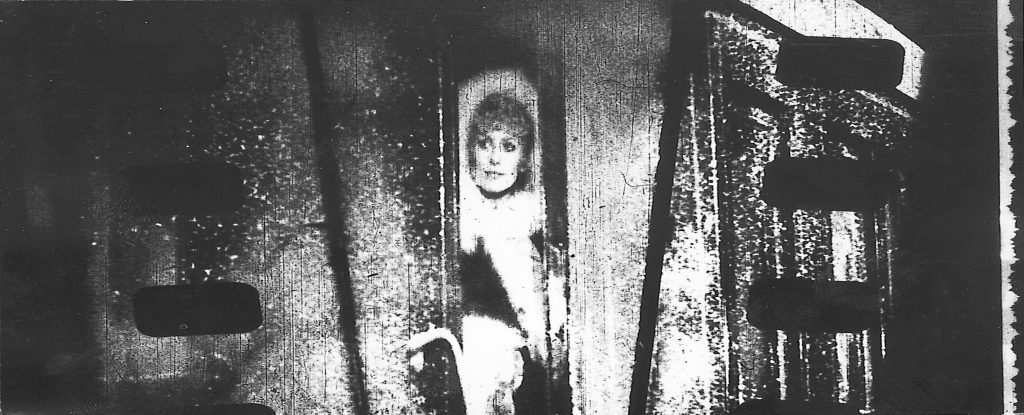
Shadows & Stations, Thrills & Desire
Imagine the station as the romantic precipice of all the journeys that could be taken, all the lives that could be led, or, conversely, as a poignant stage for farewells, missed connections, and the receding image of a face in the window disappearing without you into another future. A place of shadows for clandestine meetings, hidden in the anonymity of milling crowds, or racing against time – a last chance caught breathless on the platform. Think of David Lean’s classic, Brief Encounter (1945), in which a happenstance meeting at a train station leads to the exquisite tragic romance of what could have been. To be suspended between departure and arrival, escape and entrapment, embrace and farewell, the station becomes a cinematic territory of crossings; a spatial and temporal anomaly that exists in the drama of its potential, a non-place and time that promises a multitude of places and times.
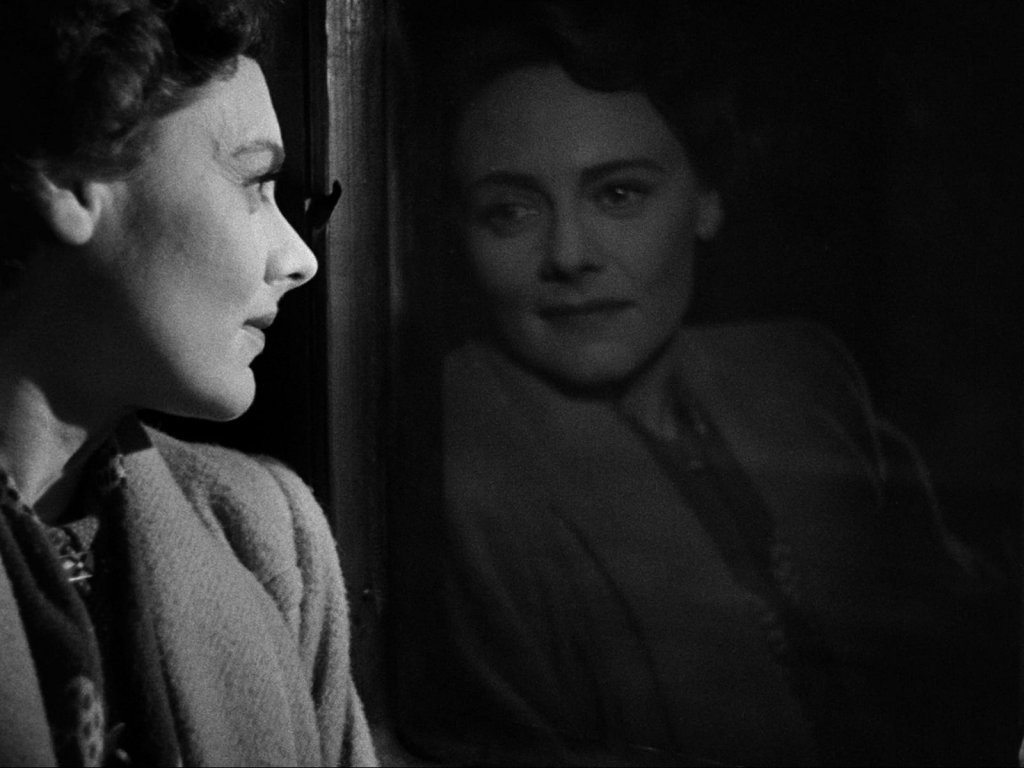
Meanwhile, from the meeting place of multiple people, places and possible times, we leave the station and step onto the carriage. The intimacy of the carriage, the strange public privacy of a speeding capsule subject to the chaos and chance of random passengers. Is it a discomforting intrusion of strangers on personal space, or the inviting sense of the personal encountered in the public? A crowding experience of claustrophobia or a chance meeting that sparks unexpected intimacy? Between the station and the carriage, cinema has found – in its locomotive dream – two symbols that are continually renewable. It also bears the trauma of war, and part of the visual legacy of the holocaust: the stations and carriages that haunt the harrowing documentary Shoah (dir. Claude Lanzman, 1985) or the stark historicity of Alan Resnais’ Night and Fog (1956).
Not unrelated to the shadow of war, was the development of film noir – in which trains and stations became a staple, both in plot mechanics and thematic potency. From the proto-noir romance of La Bête Humaine (dir. Jean Renoir, 1938), in which a murder mystery gathers dramatic pace with the tireless rhythm of the train tracks (released in the same year as one of Hitchcock’s -many- train-based capers, The Lady Vanishes) through to key scenes in Billy Wilder’s iconic Double Indemnity (1944), Hitchcock’s Strangers on a Train (1950) and the tense, cat-and-mouse-confined-to-a- train drama of a detective’s pursuit of mob assassins in the brilliant Narrow Margin (1952).

Trains and thrillers go hand in ticket-clutching hand, the train providing a convenient metaphor for the unstoppable ride that characterises the building suspense and pressure-cooker tension of a thriller’s narrative dynamics. In 1929, a celebrated and regular leading lady of British silent cinema, Pauline Johnson (star of the Toon, born in Newcastle) was seen clinging to the outside of a speeding train in Castleton Knight’s influential film, The Flying Scotsman. Often cited as the first British film to feature sound (head to head with Hitchcock’s Blackmail, also 1929), its narrative races headlong into dangerous stunts and memorable action sequences, all taking place on a sabotaged train journey. Hitchcock’s relationship with trains in cinema, as a source of romance, murder mystery, noir and action, continued throughout his career with notable examples after The Lady Vanishes. The masterful thriller featuring a getaway train escape, The 39 Steps (1939), and, starring Carry Grant and James Mason, North by North West (1959), a wise-cracking spy thriller that pivots around a tense and romantic train journey with the mysterious -and predictably for Hitchcock – very blonde, Eve Kendall (Eva Marie Saint).

Returning to the racing one-location thriller template of The Flying Scotsman, we might leap ahead to The Runaway Train (dir. Andrei Konchalovsky, 1958) starring Jon Voight and based on a story by none other than legendary Japanese director, Akira Kurosawa. It was a film that, like The Flying Scotsman, The Bullet Train (dir. Junya Satō, 1975) and Silver Streak (dir. Arthur Hiller, 1976), might be considered as part of the railway genetics behind the birth of the blockbuster 90s action franchise of Speed (a Keanu Reeves and Sandra Bullock vehicle, with emphasis on the vehicle). The first Speed (dir. Jan da Bont, 1994), boasting the tagline ‘Get Ready For Rush Hour!’, saw Keanu Reeves and Sandra Bullock bonding over a near-death experience on a bus, while Speed 2: Cruise Control was a case of same again but this time a luxury cruiser and Jason Patric. All these films adopted the same race- against-time action template of the ‘out of control’ train ride.

In other directions, branching from the central track of the thriller, we might also consider: the hostage dynamic in The Taking of Pelham One Two Three (dir. Joseph Sargent, 1974); Bong Joon Ho’s dystopian class allegory, Snowpiercer (2013) or the haunting train tunnel sequence in Memories of a Murder (2003); the genre thrills of Liam Neeson unwittingly embroiled in amurder conspiracy onboard a train on his daily commute – entitled, with imaginative flamboyance, The Commuter (dir. Jaum Collet-Serra, 2018), or, again employing the ‘embroiled in a mystery’ structure, Emily Blunt as an alcoholic divorcée drawn into a missing person case entitled, once again with dull and functional clarity, The Girl on the Train (2016); or perhaps we could buy a ticket for the locomotive retreat into costume nostalgia, with Murder on the Orient Express (dir. Kenneth Branagh, 2017) leading us back, via an extravagant moustache, into a more cosy rendering of amystery in transit… a variation on a theme, of thrills and desire inextricably linked with, and analogous to, the symbolism of trains in cinema.
Derailed in the Desert
Despite a recent archival discovery that bizarrely discovered the first Western film was in fact shot in Blackburn (on the less-than-wild frontiers of Lancashire, Kidnapping by Indians) in 1899, the origins of the genre are still more narratively developed in Edwin S. Porter’s seminal, The Great Train Robbery (1903). One particular shot is emblazoned into cinema history and would appear, at the projectionist’s discretion, either at the start or end of the film. The shot is a close-up of a man firing his pistol directly into the camera; the gun smoking, the shooter’s stern gaze directed straight ahead to meet the viewer’s line of sight in what would become a visual trope of the genre, the confrontational stand-off (think of the close-up on Clint Eastwood’s glowering stare in The Good, The Bad and The Ugly).

The narrative in The Great Train Robbery rests on the titular locomotive heist and consequently begins a precedent for the centrality of trains in the Western genre. Trains might herald an expansion of frontiers just as much as they might signal an intrusion. The train is an opportunity in an otherwise unforgiving landscape: the target of a robbery or the passing refuge for a boxcar vagrant. Alternatively, it might be a foundation for the settling of a new town, bringing an optimistic modernity that can also conversely turn to embody the fear of change or unwanted arrivals. For a genre that so often violently erased, dismissed, built over or vilified the belonging and identity of Native Americans, the Western often (but not always) trades in simplified binaries: Law and the Outlaw, Cowboy and “Indian”, Good and Bad, the Wilderness and Civilization, Humanity and Nature, Community and the Individual, Settler and Nomad, Industrialist and Farmer, Hero and Villain etc.
It is a genre that rests on the conflict of archetypes and subsequently the train is often a plot device to connect, heighten or enable those conflicts. For films that deal in the near-mythical structures of moral codes and conquest (additionally drawing inspiration from Arthurian Legend and Samurai culture), the train becomes the ‘iron horse’ embodying the ‘heroic’ arrival of order. However, split with the duality of warring binaries, the train is also the complacency of man accustomed to technological support – shielded from the elements, out of the saddle and into the carriage –and becomes an entitled passage of travel that suggests cushioned civility vulnerable to the ‘noble’ interruption (robbery, attacks) of vigilante figures, those heroic constructs: ‘true’ warriors of the land.
Any number of classic Westerns (and Spaghetti Westerns) could be chosen, almost at random, that would provide ample rail-time to explore the role and significance of the train in such a vast and evolving genre. An eclectic curation of examples could be made from Jesse James (dir. Henry King, 1939), through to High Noon (dir. Fred Zinneman, 1952) and 3:10 to Yuma (dir. Delmer Davies, 1957); or from Once Upon A Time in the West (dir. Sergio Leone, 1968), Butch Cassidy and the Sundance Kid (dir. 1969) and The Wild Bunch (dir. Sam Peckinpah, 1969), through to Unforgiven (dir. Clint Eastwood, 1992), The Assassination of Jesse James (dir. Andrew Dominik, 2007) and, more recently, The Harder They Fall (dir. The Bullitts, 2021).
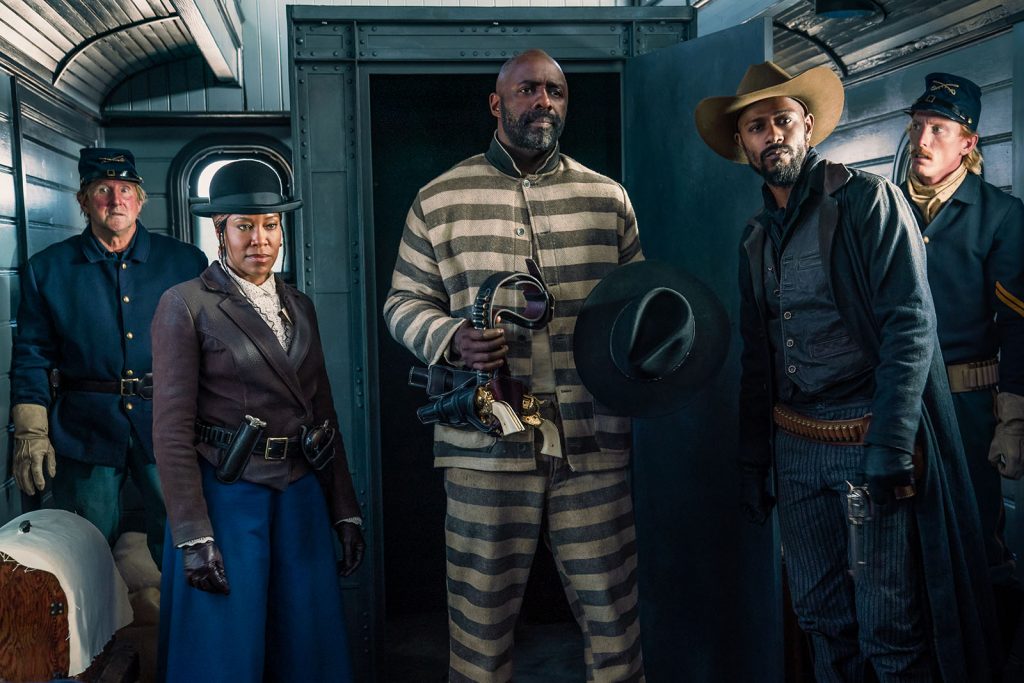
Just over twenty years after The Great Train Robbery, another landmark title in the early evolution of the Western arrived in the form of John Ford’s silent epic The Iron Horse (1924). Ford would go on to direct Stagecoach (1939), Fort Apache (1948), The Searchers (1956) and The Man Who Shot Liberty Valence (1962) and other – for better or worse –founding classics of the genre. Ford’s Westerns were fascinated with historical specificity (usually 1860s and 1870s) and its relation to mythic retelling, shadows of the Civil War (1861-5) and, although very much subsumed with patriotism, a recurrent interest in the struggles between individualism and community. Not only does The Iron Horse place the building of a railway at the centre of its epic sweep, but Ford also formally dedicated the film to the railway pioneer George Stephenson. The admirably mad ambition of the film involved 5000 extras, alongside 1,300 buffalo, a casual 2,000 horses, the construction of two small towns and the employment of 3,000 railway workmen to lay the tracks (as Fox’s original 1924 press book for the film boasts, ‘[n]o amateur could put down lengths of iron as these men do’).

The Trains we Missed
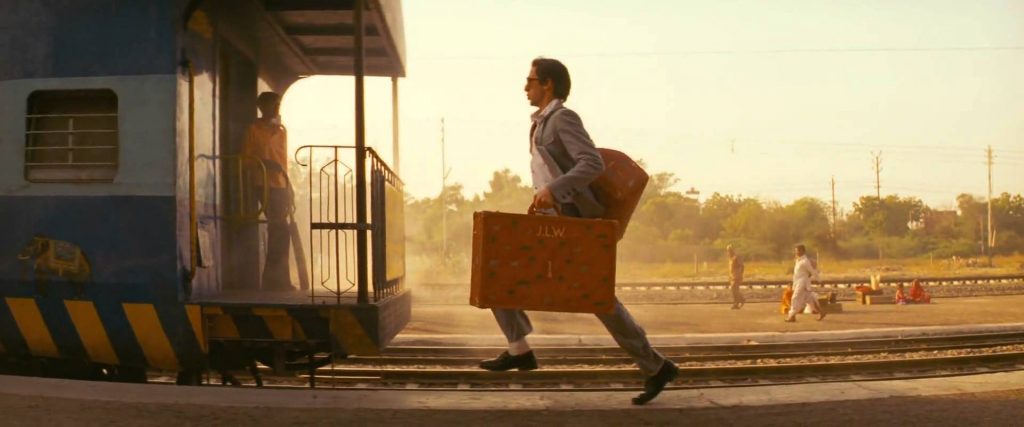
We could have mentioned many, many more films… there always more… from the ghost train possibilities of Horror, to films that lie outside of genre. We might board the filmic platform once more to watch [long intake of breath]: the many passing trains in Yasujirro Ozu’s filmography; the solemn and contemplative railroad sequence in Andrei Tarkovsky’s Stalker (1979); the dismay of Jànos, running breathlessly along the rail tracks in Bela Tar’s mournful masterpiece, The Werkmeister Harmonies(2000); the cosmic dominoes of chance that are set in motion by catching or missing a train in Kieslowski’s Blind Chance (1987); Lars Von Trier’s Europa (1991), a Kafka-inspired runaway train narrative that propels its feverish nightmare into a future built from the past; the opening to Ingmar Bergman’s The Silence (1963), which introduces its characters in the disquieting atmosphere of a train carriage, a place contingent on the placeless motion of travel that later haunts the corridors of the next (non-)location, a hotel; the mythical and poetic desolation of Theo Angelopoulos’ Landscape in the Mist (1988), in which two children continually return to a train station where they believe their father to be living and then find themselves drifting into a meditative journey akin to a kind of lonely odyssey; the arch humour and meticulous framing of Wes Anderson’s Darjeeling Ltd. (2007), uniting estranged brothers on the close-quarters comedy of a train; or the decaying surrealism of The Hourglass Sanatorium (1973), which begins with the journey of a dilapidated train that travels deep into the convoluted heart of Wojciech Has’ adaptation of Bruno Schulz’s work… a phantasmagorical maze of association, memory and, naturally, the spectral presence of a blind train conductor.

But now, without further ado, the time nears, a new train approaches and we come to our five recommendations. Rather than recommendations specific to either Compartment no. 6 or Return of the Railway Children, Reel Recommendations bases the following five recommendations on their common ground, the groundless and ground-covering thunder of trains in film…
WE RECOMMEND
La Roue (dir. Abel Gance, 1923)
“There is the cinema before and after LA ROUE as there is painting before and after Picasso.” – Jean Cocteau
What kind of self-respecting list doesn’t have space for a seven hour silent epic of pioneering montage techniques, heroic tragedy, incest, blackmail, mountains and -naturally- a multitude of trains. Existing in five versions, varying in length from four and a half hours to seven (or nine, sources disagree), Abel Gance’s phenomenally inventive and ambitious film managed to transform the syntax of cinema, and did so through the hurtling locomotion of the railway. When the Railroad Engineer Sisif (played by Gance regular Severin-Mars, a man possessing the most expressive and expansive brow in early cinema) rescues an orphan from a train wreckage and decides to adopt her, he begins a spinning wheel of events that spiral into forbidden desires, jealousy, grief, dreams and the all-encompassing Sisyphean struggle of existence. Through riches and poverty, across glaciers and into the mountains, this is a work of monumental imagination and technical prowess.
Similar to his poetic, anti-war vision, J’accuse (1919), and the crowning achievement of Napoleon (1927), La Roue is a film of restless experimental momentum. It is in the symbolism of the railway that Gance finds the perfect metaphor for his tirelessly advancing modernism, all whilst also evoking the tragic circularity of its human and philosophical drama; a turning wheel in which both form and content ambitiously coincide.

Shanghai Express (dir. Josef Von Sternberg, 1932)
Josef Von Sternberg’s collaborative streak with Marlene Dietrich at Paramount from 1930 to 1935 (Morocco, Dishonoured, Shanghai Express, Blonde Venus, The Scarlet Empress, The Devil is a Woman) left behind some of the most exquisitely lit and lavishly designed melodramas in cinema history. Drawing on the heady influences of Weimar cabaret and German expressionism, Von Sternberg’s films also added a baroque appetite for artifice (with more than a little pre-code libido) to concoct their very own exoticized and busy dreams of yearning. At the obsessive and fetishized centre of these cinematic dreams, amidst the reverent shadows and light (a filmic chiaroscuro that anticipates the dark seductions of film noir), was the face of Dietrich. It was Dietrich’s luminous androgyny and queered glamour that provided the hypnotic heart to these films and, in Shanghai Express, it is the power of her iconic look that becomes the most absorbing drama.

The film opens with a bustling station in China (heavily subject to Sternberg’s imagination and all shot in California) as a train slowly, very slowly, begins to depart; streams of chickens are scattered across the tracks, a gaunt cow stares up at the huge locomotive and refuses to move, and there are tangling flags, streamers and crowds hurrying about in ravishing disarray. The characters are introduced with various shades of problematic representation, but, for all that feels uncomfortable in the recreation of Asian culture, Sternberg also demonstrates a critique of colonialism and, though uneven, an awareness of race that was largely absent in most films of the time from Hollywood.
Set in China’s Civil War (1927-1949), the train is commandeered by a rebel army who are looking to capture a passenger deemed important enough to take hostage and trade with the government in exchange for valued aide. Dietrich plays an infamous courtesan alongside Anna May Wong (considered the first Chinese American film star, previously appearing in Douglas Fairbanks’ 1924 silent classic, The Thief of Bagdad) and, despite the commandeered train and demands of warlord Chan (Warna Olan, a Swedish-American who was no stranger to performing in racist caricature, having appeared in 1927’s The Jazz Singer and going on to play ‘Fu Manchu’), the action is always most convincingly visible in Dietrich’s costumes and the near-religious light that moves so lovingly across her face. What the train becomes in Shanghai Express is both pure spectacle, a forceful image of power and movement, and the stage for pure spectacle: with carriages and windows providing frames within frames, and the interrupted journey furnishing Dietrich’s seductive power play, agency and ambiguity with the incidental mechanics of plot. In a way, despite the train always trailing far behind Dietrich’s visual eloquence, Von Sternberg seems to realise it real power as a metaphor: another form of technology, like cinema, that manifests the emotional force of speed and movement made manifest.

Closely Observed Trains (dir. Jiří Menzel, 1966)
Recently the subject of the extraordinary and expansive documentary on Czech New Wave cinema, CzechMate: In Search of Jiří Menzel (dir. Shivendrah Singh Dungarpur, 2018), Jiří Menzel created films that magically captured a subversive contemplation of political oppression and ideological dogmatism through sly comedy, imaginative humour and surprising levity. Closely Observed Trains (Ostře sledované vlaky, also known as Closely Watched Trains) was Menzel’s unique debut, winning the Best Foreign Language Oscar in 1968.
Nearing the end of World War II, Miloš Hrma (Václav Neckár) is a young man beginning work as a train dispatcher during the Nazi occupation of Czechoslovakia. As proud of his uniform as he is of his eccentric family and aspiring to the sofa-bound, early retirement of his father, Hrma is mainly focused on that oh so awkward adolescent grail: losing his virginity. What is essentially a stumblingly sexual coming-of-age story manages, through Menzel’s vision, to become a wry and gently humorous social critique of power and vulnerability that, by its end, achieves a very real and emotional force. The railway station becomes the conflicted locus of all Menzel’s comic wit and devastating tragedy; a place where the pretence of order, control and bureaucratic power gives way to a more elemental chaos.
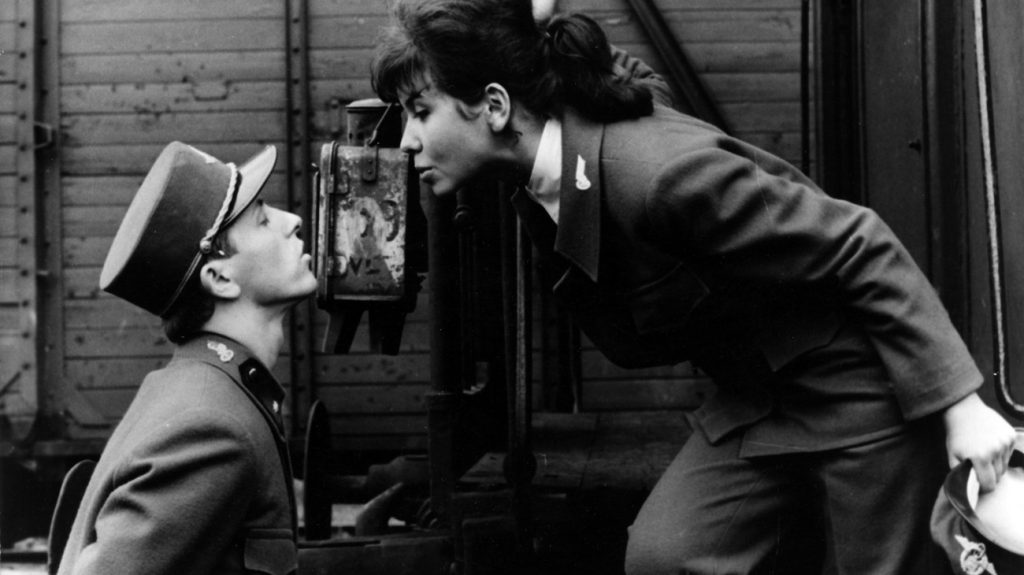
Before Sunrise (Richard Linklater, 1995)
Jesse (Ethan Hawke) meets Céline (Julie Delpy) on a train from Budapest, as they disembark in Vienna their conversation continues and – with the logic of a meandering stream of consciousness – their connection develops into romantic possibility. As the topics of conversation weave in and out of the existential and intimate, it’s hard not to get caught up in the romantic thrill of a film that fundamentally asks what if? What if life had taken a different track? What if it still can? What choices have we made, consciously and unconsciously, and where are we going…and who should or could we choose as a companion on this unfolding journey?
Richard Linklater takes a simple premise and allows it to draw deeply from the attractive frisson of anonymity. Meeting through chance, everything latent with the spark of new possibilities: of travel and change, of two people who hardly know each other exploring a city neither know and to then consequently encounter the world, and its feeling, anew. The train lends their conversation the momentum of travelling and then, in their wandering, transposes that momentum into the wandering enchantment of the flaneur: a chance to embrace chance, to see new sights and become new people.

Their time together is also, significantly constrained – over the roaming period of a night. The time vacillates between its bittersweet limitations and the temporal blur that comes through conversation… a sense of infinite tangents and convolution. In this sense, the film draws upon the modernist tradition of reading all times into one time… and though far from spiralling into the density of allusion in James Joyce’s Ulysses or the temporal poignancy of Virginia Woolf’s Mrs Dalloway, it does share the sense of an everyday epic that – with Linklater’s own slacker candour – joins another modernist tradition of associating trains with new temporal and spatial displacements of self. However, in spirit, this is nothing to do with modernist ambition or invention, instead it is arguably a postmodern yearning for the nostalgia of connection; a way out from the hollowed consumer-driven distractions of a booming 90s economy of excess, returning to a romanticised Europe of meaningful conversation, poetry and the romance of a chance encounter on a train.
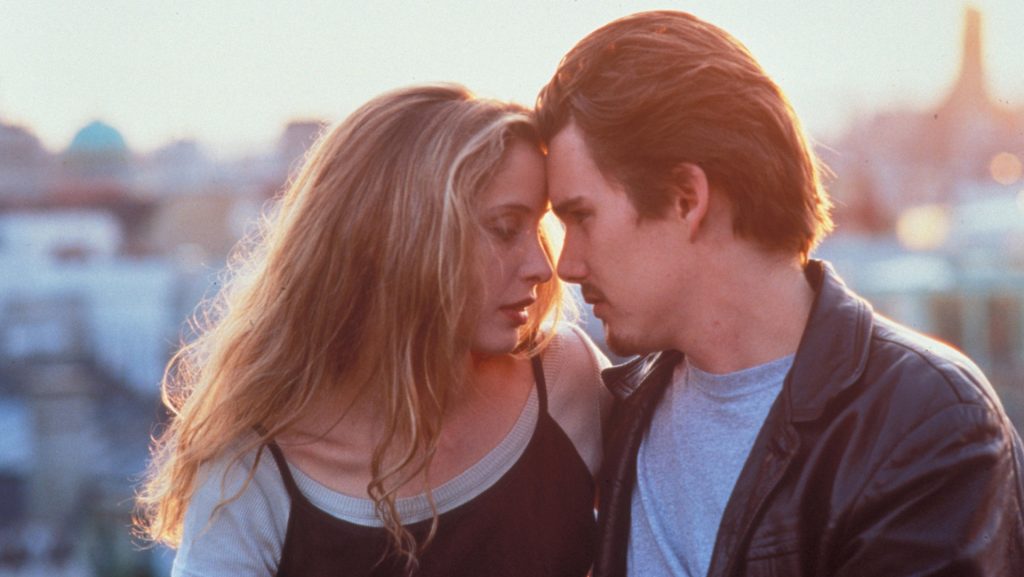
Train To Busan (dir. Yeon Sang-ho)
Stamp your ticket, take your seat and hold onto your brains…
The first ‘zombies-on-a-train’ film is generally considered to be Horror Express (dir. Euginio Martín, 1972) starring Christopher Lee and Peter Cushing, in which the Trans-Siberian Express is suddenly prey to the frozen remains of what might be the missing link in human evolution but is also, more pressingly, fairly keen on killing passengers and -once suitably defrosted – goes on a rampage that ends in an alien force resurrecting victims as zombies. Pretty fun. Train to Busan takes a more traditional zombie approach, drawing on the social commentary that has characterised much of the genre from George A. Romero onwards.
Seok-Woo (Gong Yoo) is a work-addicted and divorced father mired in cynicism and the guilt of frequently disappointing his young daughter, Su-An (Kim Su-An). In attempt to make up for his recent failings as a father, Seok-Woo grants Su-An’s wish to accompany her on the KTX 101 train to Busan in order to visit her mother and celebrate her birthday together. Sadly, inevitably, there is an ill passenger onboard…and the infection spreads quickly. The hurtling action, tension, emotional force and incisive social satire breathes new and ragged life into the ever advancing undead genre. It arrives as the graphically contorting and bloody descendant of Horror Express but is scrambling with all the energy of 28 Days Later (2002) and the satirical bite of Snowpiercer (2013).
Train to Busan returns us to the fear, entertainment and speed of locomotive thrill that audiences felt in 1896, as the Lumiere Brothers’ recorded the train rushing into the station. Whether or not audiences ran from their seats, Reel Recommendations likes to imagine that artefact of cinema history spoken back to, connected over the trans-historical tannoy of locomotive séance with Sang-ho’s zombies (two trains circling on the same cosmic wheel) and that, if in doubt, we should always run!
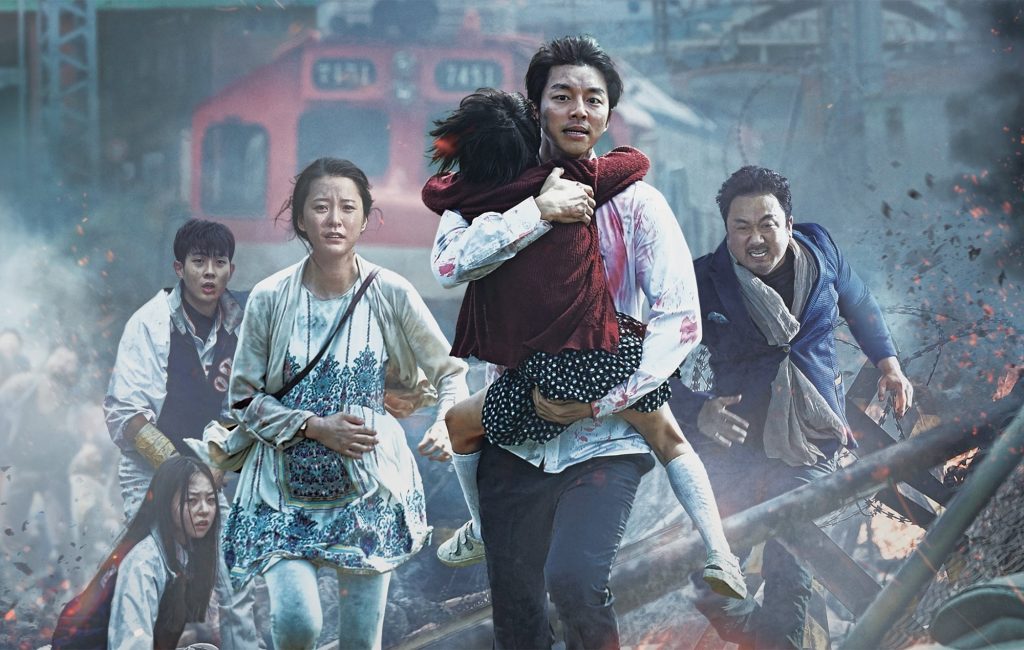
Visit our Letterboxd list of this edition of Reel Recommendations here.